5) Methodological Approach5.1 Research plan 5. 1 Research planThe present pilot study is aimed primarily at obtaining an explorational quantitative and qualitative understanding of the so-called ‘dark number.’ Here,
Though it is true that different approaches to the 'dark number' and the use of the snowball method cannot ensure representativeness, this way of going forward does help to minimize gross statistical distortions in the selection of research participants. The original intention was to carry out the present study in the form of semi-structured interviews, which were to be validated with the Heidelberg Structure-Imposition Technique. (Scheele & Groebeo, 1988). Although it had gotten as far as a rough draft for the interview procedure, at a later point in time, that too was ultimately discarded. It may be found in the appendix of the present work (pg. 138). In the final analysis preference was given to the questionnaire method, because through it, a large number of respondents can be reached relatively quickly. Moreover, in contrast to the interview method, the questionnaire method has the advantage of better ensuring participants' anonymity. 5.1.1 Establishing contact; recruitment sources and methodsThe initial contact established with the ‘dark number' occurred over the Internet, with members of self-help groups. The author represented himself as an interested citizen who wanted to be informed on the subject of pedophilia directly by those affected, as well as become acquainted with their point of view. At the same time, he also mentioned his research interests (pedophilic men’s social and psychical situations). Furthermore, personal contact was established with disseminators who were widely trusted by this sexual scene.
Sixty-seven 'dark number' participants were recruited, along with an additional five 'light number' participants.
The collection period stretched over some six months (February 2004 until the end of July 2004. Table 1 - Overview of recruitment sources /methods
5.1.2 Participation Rate[47] The participation rate can only be determined in a very rough sense. Overall, there were close to 200 questionnaires in written form distributed to various third persons, only a small portion of which could have been exhaustively circulated. About 60 questionnaires were presumably not distributed at all. This figure represents a rather low estimate. The established gross rate of participation would amount to at least 60% (82 participants; including secondary pedophiles, with a net participation rate of at least 50% (72 participants; excluding secondary pedophiles). The following factors have presumably contributed to this relatively high participation rate:
5.2 Demographic data and factors influencing components of self-concept, feelings of being under stress, and sense of well-being5.2.1 Sexual OrientationThere were 82 participants recruited, of whom 72 were, based on their sexual representations, classified as primarily pedophilic. The remaining ten participants were classified as secondarily pedophilic, and are not considered in the analysis. With the major portion of primarily pedophilic participants, what we have are
participants were able to be recruited. Fig 7 - Sexual orientation of primarily pedophilic participants
5.2.1.1 Approach to Determining Primary Pedophilia in This StudyFor the presence of "true" pedophilia, the classification criterion of “sexual fantasies" with regard to the characteristics of orientation, intensity, and temporal duration (of their existence) was chosen.
5.2.1.2 Intensity and Direction of Sexual Fantasies (Classification Schema)Among the men in this sample classified as homosexually pedophilic, there was a minority who also had a slight sexual erotic interest in girls (five participants). In close to a fourth of the homosexually pedophilic men (24.6%), a small degree of attraction to adult partners was also found. More of the subjects "sometimes" felt themselves drawn to men than to women. Fig 8a - Intensity and direction of sexual fantasies among men classified as primary homosexually pedophilic (N=61)
Among the men in this sample classified as heterosexually pedophilic, five research participants also evinced a slight sexual/erotic interest in boys. Furthermore, in one participant, a slight attraction to women as sexual partners was detected. Fig 8b - Intensity and direction of sexual fantasies among men classified as primary heterosexually pedophilic (N=7)
Fig 8c - Intensity and direction of sexual fantasies among men classified as primary bisexually pedophilic (N=4)
The men classified as bisexually pedophilic showed a clear interest in boys and girls (Fig. 8c). All four participants from this sub-sample also felt themselves drawn [49] sexually to adults to a slight degree (three participants towards men, one participant towards women. Of the ten selected-out secondarily pedophilic participants, half were heterosexual and half were homosexual. Two of the homosexual men evinced a slight bisexual tendency. The classification criterion, whether someone is hetero-, homo-, or bisexually-assessed, was determined here -- in contrast to the primarily pedophilic participants -- solely by the gender of the adult sexual attraction. Fig 8d - Intensity and direction of sexual fantasies
among men classified as secondary pedophilic
|
|||||||||||||||||||||||||||||||||||||||||||||||||||||||||||||||||||||||||||||||||||||||||||||||||||||||||||||||||||||||||||||||||||||||||||||||||||||||||||||||||||||||||||||||||||||||||||||||||||||||||||||||||||||||||||||||||||||||||||||||||||||||||||||||||||||||||||||||||||||||||||||||||||||||||||||||||||||||||||||||||||||||||||||||||||||||||||||||||||||||||||||||||||||||||||||||||||||||||||||||||||||||||||||||||||||||||||||||||||||||||||||||||||||||||||||||||||||||||||||
|
|
Always |
Often |
Some-
|
Rarely |
Never |
No
|
Boys |
0 | 4 | 5 | 1 | 0 | 0 |
Girls |
0 | 2 | 1 | 2 | 4 | 1 |
Men |
0 | 5 | 0 | 2 | 3 | 0 |
Women |
0 | 5 | 2 | 0 | 2 | 1 |
With regard to sexual arousability by children, among the heterosexuals in this sample, it was shown that two of the participants "often” felt themselves sexually attracted to boys, and one participant "often" felt himself sexually drawn to girls. In one participant there existed a stronger ("often"), and in an additional one, a less strongly pronounced ("sometimes”) interest in boys or girls.
Heterosexual participants' interest in child stimuli was present in homosexually pedophilic, heterosexually pedophilic, and bisexually pedophilic forms. The homosexuals in this sample evinced an exclusive sexual interest in boys. In one participant, more of a pronounced attraction ("often") was present, and in an. additional four, a less pronounced ("sometimes”) attraction was present.
At the time the data was collected, the bulk of the research participants were between 26 and 50 years of age. The youngest participant was 19, the oldest, 68. The average age was 38.5 years, with a standard deviation of 12.6 years.
As the age distribution in Table 2 makes clear, both young as well as older men were receptive to the study. The 21-30 and 31-41 age groups were somewhat more strongly represented than other age groups.
Age group |
Number |
% |
| < 21 years old | 1 | 1.4 |
| 21-30 years old | 21 | 29.2 |
| 31-40 years old | 24 | 33.3 |
| 41-50 years old | 13 | 18.1 |
| 51-6- years old | 7 | 9.7 |
| 61-70 years old | 6 | 8.3 |
Combined age groups |
||
Group |
Age |
N |
| 1 | 19-30 years | 22 |
| 2 | 31-40 years | 24 |
| 3 | 41-50 years | 13 |
| 4 | > 51 years | 13 |
The research participants were combined into four age groups. Due to the lower representations of the higher age groups (51-60 as well as 61-70), [50] these two groups were combined into a single category of those 5l or older. The 19-year-old was considered part of Age Group 1, in order to avoid having an under-21 category.
The distribution in Table 3 constitutes the basis for age-group comparisons of participants with regard to pronounced psychical characteristics.
| Age Group 1 encompasses early adulthood, | |
| Age Group 2 early middle-age, | |
| Age Group 3 middle-age, and | |
| Age Group 4 middle-age and the beginning of old-age. |
Homosexually, heterosexually, and bisexually pedophilic participants are relatively homogeneously distributed over the four age-groups. There is no significant relationship between the characteristics of age-group and pedophilic orientation.
Furthermore, there is no significant association between the characteristics of age-group and recruitment source/method. Participants from self-help groups are primarily found in the 26-50 age-range (average age 38.4), standard deviation 12.0 years). At the time the data was collected, the average age of the participants who were recruited by means of the snowball method was 36.9. These are found primarily in the age-range of between 24 and 50.
| Two-thirds of research participants (66.7%) had attended an academic course high school [Gymnasium], | |
| one-quarter (25.0%) had gone to a non-classical secondary school [Real/Mittelschule], and | |
| one in every
twelve (8.3%) had attended primary school [Hauptschule]. | |
| The bulk of the research participants had attended or currently attend university (39.4%) or | |
| junior college [Fachhochschule] (21.1%), and | |
| an additional 33.8%, vocational school. | |
| Four participants (5.6%) did not have any post-secondary education. One person provided no information. |
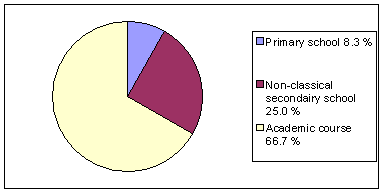
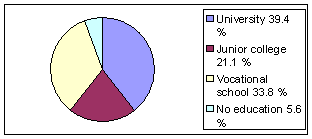
Consequently, close to two-thirds of participants had gone through more advanced schooling and achieved higher educational levels; with somewhat less than a third, there were moderate levels of schooling and education. And in a small portion of the studied population (ca. 7%), levels of schooling and education were low.
The characteristics of schooling and educational level are distributed relatively homogeneously among the age-classes. There is no significant association between age-group membership and schooling or age-group membership and educational level.
At the time of the study,
| 35 subjects were working people (48.6%) and | |
| 14 participants were unemployed (19.4%). | |
| Twelve participants were students (16.7%) and | |
| two were in civil or military service (2.8%). | |
| Eight subjects were retirees (11.1%). The retiree category also includes two early retirement participants, ages 37 and 46. | |
| One person (1.4%) provided no information. |
An overview is provided in Figure 11. [51]
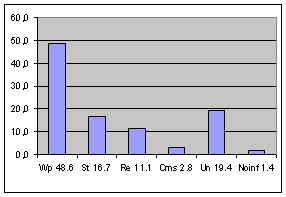
The figures given are percentages
Wp = Working people
St = Students
Re = Retirees
Cms = Civil-/military service
Un = Unemployed
Noinf = No information
In a research population of predominantly higher schooling and educational levels, the portion of unemployed is itself strikingly high. In personal conversations as well, those concerned will occasionally point out that a considerable share of members of this sexual scene has little income or is unemployed.
The characteristic "occupational status" is non-homogeneous relative to the characteristic "criminal proceedings" (exact Fisher test p=0.034).
| Fewer students (6.7%) and | |
| working people (28.6%) than | |
| retirees (50%) and | |
| those who were unemployed (50%) |
had had run-ins with the legal system.
The average age of those
| unemployed was 37.6 (standard deviation 9.0; | |
| for the working people it was 38.9 (standard deviation 10.7). |
Participants who were unemployed or working people were distributed relatively homogeneously across the four age groups. There is no significant association between the characteristics of "age group" and "working" (comparing working people with the unemployed).
The association frequently encountered in the literature, that pedophiles would mainly go into (pedagogical) professions (e.g., Bundschuh, 2001, pg. 138) where they would have frequent contact with children, could not be confirmed by the statements of the population studied.
Figure 12 gives an overview of the current fields of occupation as well as the professional training of the research participants to be found there (N=50).
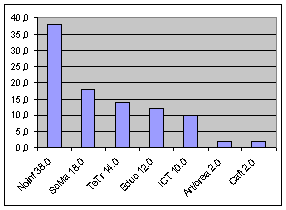
Noinf = No information
ScMa = Science / Management
TeTr = Techniques / Traffic
Educ = Education
ICT = Information & Communication Technology
Art/Crea = Arts or creative job
Craft = Craft
For reasons of anonymity, the individual occupations cited were combined into general categories. Two independent raters had an average concurrence of 92.9% across all categories.
It was a colorful palette of the most diverse occupational fields, in which they were skilled as well as working. With regard to age-structure, participants from all four age-groups were to be found in the most common occupational fields (business/administration, pedagogical sphere, and technology and engineering). Nineteen research participants (38.0%), presumably due to fear of loss of anonymity, did not respond to this question.
|
Sixty-four of the participants were single (88.9%), | |
|
four participants were married (5.6%), | |
|
two were divorced (2.8%), and | |
|
two participants lived in same-sex partnerships analogous to marriage. |
Six participants (8.3%) had children of their own. Of the fathers, there were two heterosexually pedophilic and four homosexually pedophilic participants, in Age Groups 2, 3, and 4.
One-quarter of the pedophilic participants (N=71 here) judged the statement, "many pedophiles will co-habit with an adult partner in order to prevent their sexual preference from becoming outwardly obvious," to be applicable to themselves personally (25.4%), and in the case of one participant (1.4%), as very applicable. The men who made these statements were found predominantly in the 31-48 age range (Age Groups 2 and 3).
|
There were no pending criminal proceedings against 67 of the participants (93.1%) at the time of data collection. | |
|
Two participants (2.8%) provided no information, and | |
|
three participants (4.2%) were under criminal investigation at the time. |
Nearly a third of the participants (30.6%) had previous convictions for violating the right to sexual self-determination (Article 13 StGB - fines and/or prison sentences).
No statement is able to be made as to whether the criminal acts involved offenses relating to child pornography (§184) or actual pedosexual contacts (§§174, 176, 177, 180, 182).
Participants' relative frequency of having had one or more previous criminal convictions progressively increased across age-groups, from 13.6% up to 61.5%.
There is a significant association between the characteristics of age-group and past criminal proceedings (exact Fisher test p=0.010).
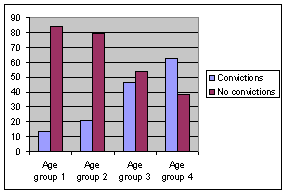
[53] Of the participants with previous criminal convictions (N=22),
|
one participant saw the conviction as appropriate and | |
|
16 participants (72.7%) viewed them as inappropriate. | |
|
Three participants (13.6%) evaluated the conviction as appropriate in and of itself, but not the extent of the punishment. |
The participants made a distinction with regard to their first and second convictions: both regarded their first convictions as fully justified, but not their second.
Thirty-eight participants had some experience with therapy, and are distributed among all four age-classes. Therapy experiences were somewhat increased among participants in Age Group 4, and a bit less common among those in Age Group 1.
There is, however, no significant relationship between the characteristics "age-group" and "therapy experience." This means that younger and older participants do not differ with respect to the presence of psychotherapy experiences.
At the time of data collection,
|
19 participants (26.4%) were in psychotherapeutic treatment. | |
|
An additional 19 participants (26.4%) had previous experience with psychotherapy. | |
|
Thirty-four participants (47.2%) had no experience with psychotherapy. |
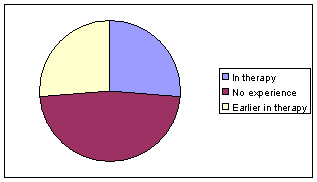
The homogeneities of all demographic characteristics and influence factors were tested against one another by means of the chi-square test (hypothesis: homogeneity present), in order to be able to adequately evaluate the results regarding
|
self-concept characteristics, | |
|
feelings of being under stress, and | |
|
sense of well-being. |
What emerged overall was a picture of negligible confounding variables. In the following, only those results which are believed to be crucial for purposes of interpretation will be listed.
|
The characteristic “age-group" is non-homogeneous relative to the influence factors of
| |||||||
|
The influence factor "recruitment source" is non-homogeneous relative to the characteristic "criminal proceedings" (exact Fisher test p=0.005).
|
|
[54] It was predominantly 'dark number’ homosexually pedophilic men who took part in this study. Only a very small number of heterosexually and bisexually pedophilic men were able to be reached. | |
|
The age-structure of the participants extended from early on up to later adulthood. Men taking part who were between 21 and 40 years of age were slightly over-represented. | |
|
The bulk of the participants had above-average levels of education and worked in quite varied occupational areas. A considerable percentage of participants were unemployed at the time of the data collection. | |
|
The overwhelming majority of participants were single and only a very small number made the statement that they were living together long-term with an adult partner. | |
|
Half of the research participants had psychotherapy experience. | |
|
A third of those who took part had previous convictions for violating the right to sexual self-determination, for which they had received fines or prison sentences. Almost without exception, these convictions were characterized as unjust. |
To begin with the official procedures will be discussed, which were by no means developed by me personally, and which, due to pragmatic considerations, were merged with “Data Collection Sheet 1.” In connection with this, the two central procedures of the study that were used to estimate well-being and clinical symptomatology are presented in a brief overview. Constituting the conclusion is a series of procedures that were employed in order to capture the central self-concept characteristics.
With the socio-demographic data questionnaire, we are talking about a catalog of questions, supplied by the author, which has two goals.
|
For one, with the aid of sociographic questions, it should be possible to provide a precise description of the sample. | |||||||
|
For another, it should enable associations between selected influence factors/sociographic variables and
to be unconvered. |
"Data Collection Sheet 1" is comprised in part of a catalog of questions, from the author, concerning the areas of sexuality, socialization, social support, centrality of environment- and self-concepts, and conflict areas. In "Data Collection Sheet 1" there are also additional items which were taken from the following standardized procedures.
Four alcoholism items were taken from the Multiphasic (24 items in total), which should provide a rough idea of whether or not alcohol abuse is suspected.
There were three items taken from the MST's sex-related lying scale, in order to get a rough idea as to the frankness of the participants with regard to statements concerning their sexuality.
[55] Items were taken from the FPI-R "Openness" Scale in order to assess participants’ general social extroversion. Average and higher scores on the "Openness" Scale can point to a rather self-critical appraisal. Participants evinced the same minor weaknesses and flaws shared by most of humanity. Low or extremely low scale-scores were common among the study participants, which are believed to indicate a strong conventional social norms orientation and/or make a good impression. The internal consistency of the "Openness" Scale stands at r=.74. It is based on norms representative of the overall population.
Consisting of seven items, the Short Stress-Test makes a stress screening possible and encompasses the following areas: loss of control, loss of meaning, anger, sleep disturbances, inability to relax, current source of stress, and absence of social support. The test was evaluated on 247 persons from various samples. It has satisfactory values for the criteria-related validity and reliability of the procedure.
The TPF represents various personality characteristics which have psychological health relevance to the goal of successful stress-mastery.
The procedure was developed through the use of factor analysis and measures two independent meta-aspects of personality:
|
mental health and | |
|
behavioral control. |
In factor-analytic studies involving various constellations of variables, these meta-aspects have proven themselves able to be frequently replicated, account for a great deal of variance, and show relationships between other personality variables.
Moreover, the TPF's nine sub-scales encompass the component parts of “mental health." These are arranged factor-analytically into three spheres:
|
"mental-physical well-being," | |
|
"self-actualization," and | |
|
"self- and other-referencing assessments of worth.” |
In theory, these component parts contribute to higher values for the construct of "mental health." The nine subscales, which are comprised of some 120 items from the TPF, are described in Table 4.
| Scales for measuring ... | |
| ... highly-variant meta-aspects | (BC) Behavioral control: prudence, caution,
tendency towards order vs impulsiveness, thrill-seeking and
risk-taking
(MH) Mental health: pronounced ability to master internal and external demands, high self-esteem, a sense of meaning, high life-stisfaction, ability to carry things through |
| ... mental-physical well-being | (SF) Sense of fulfillment vs depressiveness
(SL) Selflessness vs self-centeredness (CF) Carefree-ness vs nervousness |
| ... self-actualization | (EX) Expansiveness: ability to carry things
through, self-assurance, decisiveness and dominance
(AU) Autonomy: gladly making decisions on one's own, solving problems personally, taking responsibility for one's life |
| ... self- and other-referencing assessments of worth | (SE) Self-esteem: consciousness of self,
often carefree, tranquil and balanced
(AL) Ability to love: interested in others, can give love to others, can empathize with others, ready to help |
[56] In contrast to the traditional clinical questionnaire testing (e.g., SCL-90-R), the TPF does not, in the first place, encompass a compilation of symptomatic behaviors, but instead attempts to include the entire spectrum of mental health in terms of advantageous variants (research participants' strengths and/or resources).
Norms exist for age groups of between 18 and 80 (N=961). The internal consistencies of the nine sub-scales lie between r=.77 and r=.91. The TPF is known for its distinguished psychometric foundation.
The SCL-90-R measures a person's subjectively felt impairment by physical and psychical symptoms over a seven-day time-period. It is an ideal complement to procedures for measuring the extremely temporally variable manifestations -- as well as the chronologically durable structure -- of the personality (e.g., the TPF). The procedure offers, and is utilized as, an overview of a person's symptoms of psychical stress in reference to nine sub-scales and three established values.
Scale |
Description |
| 1 - Somatization | Simple physical stress on up to functional disturbances |
| 2 - Duress | Mild disturbances in concentration or work on up to pronounced distress |
| 3 - Insecurity with social contact | Slight insecurity on up to s feeling of personal inadequacy |
| 4 - Depressiveness | Sadness on up to severe depression |
| 5 - Anxiety | Physically perceptible nervousness on up to profound anxiety |
| 6 - Aggressiveness / hostility | Irritability and lack of balance on up to severe aggressiveness with hostile aspects |
| 7 - Phobic anxiety | A slight sense of being under threat on up to massive phobic anxiety |
| 8 - Paranoid ideation | Mistrust and feelings of inferiority on up to strongly paranoid ideation |
| 9 - Psychoticism | A mild sense of isolation and alienetaion on up to dramatic evidence of psychosis |
| GSI - Global severity index | Measures fundamental psychic stress |
| PSDI: Positive symptom distress index | Measures the intensity of responses |
| PST: Positive symptom total | Provides information regarding the number of symptoms reflecting presence of stressor |
[57] For clinical samples, the internal consistencies of individual scales lie between r=.79 and r=89. The items may be said to have "face validity."
For normative samples, the inter-correlations between sub-scales is, on average, r=45. The reliability of the test profile for normative samples may be characterized as satisfactory, and for clinical groups, as good to very good.
Confirmatory tests supported the nine subscales in clinical groups above all. With the aid of a normative sample (N=1,006), sex- and education-specific T-values can be constructed.
The SAM is a personality diagnostic tool which is designed to capture, in a temporal and situational way, individuals' relatively stable (below-average, average, or above-average) tendencies to make themselves the center of attention and the object of mental preoccupation.
It has the effect, moreover, of differentiating between whether more privately- vs. more publicly- accessible aspects stand at the center of self-referent attention.
The questionnaire is composed of a total of 27 statements written in the first-person, in which five-tiered scale rankings are made.
The operational range of the questionnaire is extremely broad. It has been applied to, among others, the areas of
|
"health-related behavior and adaptation to illness," | |
|
"social interaction," and the | |
|
"validity of self-related information." |
Consistency measures exist for various samples (N=1,251), ranging from r=.71 to r=.87. Reliability measures are satisfactory (r=.72 to r=.84). The face-validity of both sub-scales has been established by studies involving various samples. There are, in addition, a large number of indications as to the construct-validity of the sub-scales as well as their differential validity.
[58] With the Scales for measuring the self-image of functional social potency, we are talking about a procedure that captures the components of self-concept which are important in mastering social demand situations.
The procedure does not actually measure “objectively" present social skills but instead illustrates the self-appraisal of fundamental social capabilities which, nevertheless, can have a strong act-regulating function.
Schröder (1985, pg. 28) characterizes "functional potency" as the
"basic ability to resolve interpersonal demands and the self-understanding of one's own 'effects' on or 'effectiveness in one’s own life-sphere."
The questionnaire consists of 67 items which are meant to be evaluated, on a bipolar (-4 up to +4), nine-tiered scale, with regard to their applicability to one's own self. The items are divided into four scales, which are described as follows in Table 6.
| SSF-C: Communicability of self-concept |
General ability to communicate, i terms of a readiness to establish and shape social contacts |
| SSF-D: De-centering of self-concept |
The ability to cognitively and emotionally put oneself in the shoes of one's inter-actional partner |
| SSF-E: Consciousness of one's control over the environment |
The extent to which one believes one is able to have an influence on and control over the conditions of one's social surroundings |
| SSF-S: Consciousness of self-control |
Reflection upon the extent to which one is able to control and regulate one's own internal demand-structures (successful self-regulation) |
Comparison values from a psychically unexceptional heterosexual control group of men and women (N=33) exist for the SSF (from Hempel, 2001).
The MSSCQ captures, in the original American version, 20 psychological aspects of human sexuality and consists of 101 items. The test subject is asked to decide to what degree each given statement fits him (Likert scale 0-4). The values for the 20 sub-scales are derived from the arithmetic average of the item responses. Though normative values exist for the American original, there are no German norms.
For the present study, four items from the MSSCQ were slightly modified and adapted to the special problems associated with this topic of research. For example, instead of being adopted from the original, the concept of “sexual disorder" was replaced with "sexual orientation."
Comparison values from a psychically unexceptional heterosexual control group of men and women (N=33) exists (from Hempel, 2001). Table 7 provides an overview of the MSSCQ sub-scales. [59]
| 1 | Sexual anxiety | Attitude toward and discomfort and anxiety regarding one's own sexuality |
| 2 | Sexual self-efficacy | Belief in the ability to handle one's own sexual aspects (e.g., feeling oneself to be capable of seeing to it that one's sexual needs are met |
| 3 | Sexual consciousness | Degree of consciousness of and clarity regarding one's own sexual desires and needs |
| 4 | Motivation to avoid risky sexual practices | The motivation to avoid sexual practices which pose a danger to one's health |
| 5 | External sexual control (fate) | The conviction that one's own sexual life is determined by luck and opportunity |
| 6 | Sexual fixation | Addictive and compulsive thoughts about sex |
| 7 | Sexual carrying-out / clarity | The tendency to want to energetically carry out one's sexual desires and needs |
| 8 | Sexual optimism | The expectation that one's future sexual life will be a promising and rewarding one |
| 9 | Blaming oneself for sexual problems | The tendency to assign blame to oneself when one's own sexuality is experienced in a negative or undesired manner |
| 10 | Sexual self-monitoring | The tendency to be conscious of the general impression others have of one's sexuality |
| 11 | Sexual motivation | Impetus and wish to have sexual relations |
| 12 | Sexual responsibility for solving sexual problems | The feeling that one is personally responsible for solving one's sexual problems (and here for one's sexual orientation as well) |
| 13 | Sexual self-respect | The tendency to have faith in one's ability to have sexual encounters and to experience one's sexuality in satisfactory, pleasurable ways |
| 14 | Sexual satisfaction | Satisfaction with the sexual aspect of one's life |
| 15 | External sexual control (powerful others) | The conviction that the sexual aspects of one's life are directed by others more powerful and influential than oneself |
| 16 | Sexual self-schema | Self-appraisal as a sexual partner (e.g., the desire to be an attractive sexual partner; the ability to be in sync with a sexual partner |
| 17 | Sexual fears | Fear of letting oneself get involved in sexual relationships and sexual contacts with others (here adults and children) |
| 18 | Consciousness of sexual problem | The conviction that one is able to protect oneself from physical sexual problems and disorders (e.g., organically-conditioned erectile dysfunction) |
| 19 | Sexual depression | Feelings of sadness, dissatisfaction, and depression in connection with one's sex life |
| 20 | Internal sexual control | The conviction that the sexual aspect of one's life can be determinated and controlled by oneself |
[60] For the evaluation of the data, the “SSPS 11.5” software was utilized. The descriptive measures of frequency, mean, and standard deviation constituted the description of the sample.
To the questionnaire responses, the methods of both
|
explorative data analysis | |
|
parametric and non-parametric static testing procedures [e.g., chi-square test, T-test, U-Test, and (rank-) variance analysis] were applied. |
To assess the associations between variables, bi-variate correlations and multiple regression analyses were calculated.
For the assessment of the more open-ended questions, frequencies were tabulated, a content-based formation of categories was undertaken and a percentage homogeneity of opinion coefficient between two independent raters was determined. (Asendorpf & Walcott, 1979).
Excerpts from the
participants' personal letters, e-mails, and conversations were added to
the presentation of the results. They are regarded as a necessary
complement to the qualitative data and were taken into consideration in
the interpretation. (See Wilson & Cox, 1983.) Qualitative data have
relevance, and give a better impression of persons with this sexual
orientation than does either raw numbers or -- more to the point -- the
tragedy with which this phenomenon is typically associated.